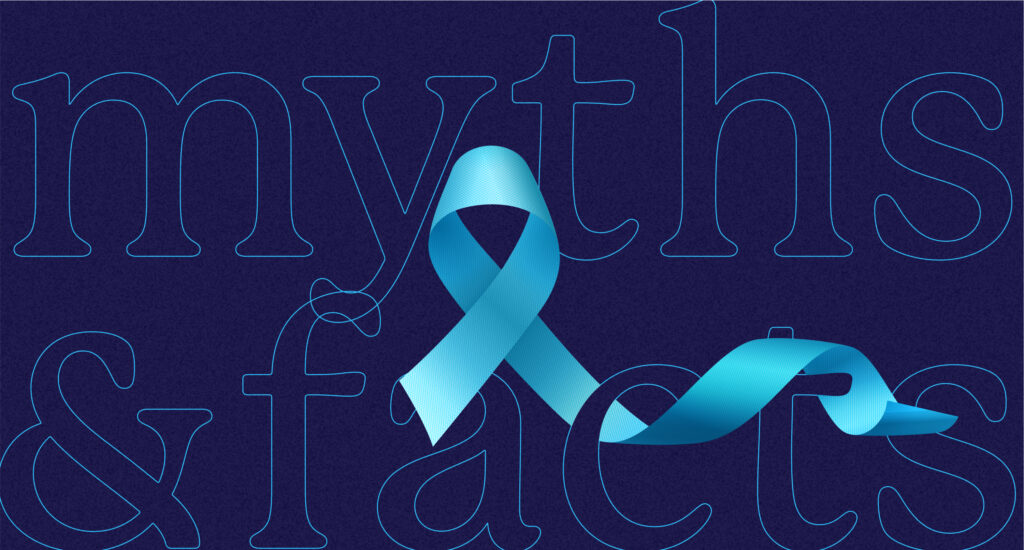Blog Post
Separating Myths from Facts: Understanding Your Organization’s Prostate Cancer Risks
Color

About 1 in 8 people with a prostate will be diagnosed with prostate cancer during their lifetime. With odds like that, everyone with a prostate should educate themselves about their risks. Period.
But how people react to the looming possibility of prostate cancer can differ unexpectedly. Fear of the unknown, along with enduring myths keeps some people from seeking out information about their health risks and taking action to maintain their wellness.
How will you help your employees manage their own risk? Asking that question today may protect you from avoidable surprises down the line.
The incidence of prostate cancer has been on the rise since 2014, increasing by nearly 3% annually. More troubling, advanced-stage prostate cancer has risen by about 5% per year in that time. This trend is particularly concerning for Black individuals, who face double the mortality rate from prostate cancer compared to their white counterparts.
These grim statistics stand in sharp contrast to advances science has made in early detection and treatment of prostate cancer – and they hint at the reason some people avoid cancer screening: the power of prostate cancer myths.
Myth: Prostate cancer treatment always leads to erectile dysfunction and/or incontinence.
Fact: While erectile dysfunction (ED) and urinary incontinence are potential side effects of treatment, many people can maintain sexual function and continence after treatment, particularly if the cancer is detected at an early stage. New procedures, techniques and technologies are making treatment safer and more effective.
Myth: Prostate cancer is not fatal.
Fact: Many prostate cancers are slow-growing, but others are aggressive, can spread to other areas of the body, and require immediate treatment. Nearly 32,250 people will die of prostate cancer in 2024, highlighting the importance of talking to your doctor about your screening options and staying up-to-date with their recommendations.
Myth: If you don’t have a family history of prostate cancer, you don’t need to worry.
Fact: The truth is, if you have a prostate, you have a 1 in 8 chance of developing prostate cancer. While having a family history does increase your risk, the majority of people with prostate cancer have no family history of the disease.
Myth: The only way to screen for prostate cancer is with a digital rectal exam (DRE).
Fact: While the DRE is one method used for prostate cancer screening, it is not the only option. Another common method is the prostate specific antigen (PSA) test. The PSA test measures the level of PSA, a protein produced by the prostate, in your blood. Elevated PSA levels can be an indicator or prostate cancer, but they can also be caused by reasons other than cancer.
Offering employees a program that helps them understand their individual risks of developing prostate cancer is key to demystifying the disease and maintaining a healthier workforce.
Prostate cancer remains a leading cause of cancer death in men. In response, Color’s partner, the American Cancer Society, advocates for “shared decision-making.” This approach educates people about the benefits and limitations of prostate cancer screening, and empowers them to make more informed personal choices. For someone with a prostate who is 50 or older with an average risk, that decision might look different than for someone with a BRCA1 or BRCA2 gene mutation whose close relative was diagnosed with prostate cancer before the age of 65.
When evaluating a cancer risk-assessment program, look for one that:
- Takes into account family history, genetic markers and lifestyle risks to help employees make informed decisions about their cancer screening and overall health.
- Addresses the myths and social and psychological barriers to assessing risk and getting screened. It is one thing to promote early detection and screening, it’s another to get employees to follow through.
- Normalizes prostate cancer screening. Knowledge is power. Screening programs should focus on staying on top of your health – preparing for anything, not bracing for the worst.
- Supports patients after screening. Those who receive an abnormal PSA result will need additional testing to clarify a possible diagnosis. This means being connected with in-person care and making sure the right next tests are ordered.
Once you’ve demystified prostate cancer risk, it is time to coordinate care. Your screening program should work closely with physician partners for follow-up care, including additional risk assessments, surveillance and treatment, if needed. For prostate cancer, screening can often start at home.
For example, through Color’s Virtual Cancer Clinic, people receive PSA kits in the mail. If someone receives an abnormal result, Care Advocates then provide support finding and scheduling in-person appointments with in-network providers. Physician partners can help debunk other prostate cancer myths, including:
Myth: All prostate cancers need aggressive treatment.
Fact: Some cases, when detected at an early stage, can be managed with active surveillance, which involves regularly monitoring the cancer progression without immediate treatment.
Myth: Only older people get prostate cancer.
Fact: While the likelihood of developing prostate cancer increases with age, younger people can also develop prostate cancer, especially if they have genetic risk factors. For people diagnosed at an early age (i.e. before 50), prostate cancer is often detected at a later stage.
Myth: Prostate cancer has detectable symptoms.
Fact: Early-stage prostate cancer often has no symptoms, which is why screening is important. However, if you are experiencing problems urinating or blood in the urine or semen, talk with your doctor.
Myth: A high PSA level equals cancer.
Fact: PSA levels can be elevated due to various non-cancerous conditions like prostatitis or benign prostatic hyperplasia.
To learn more about prostate cancer, including risks and useful resources, visit Color here. Employers interested in screening programs to help their workforce, please register for our prostate cancer webinar here.

